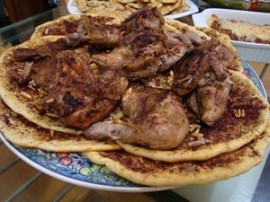Nothing beats the smell of fresh picked Nana. It is so delightfully refreshing and Jordanians use it in a handful of wonderful ways. What pray tell is Nana? First of all it is really نعناع which when transliterated correctly looks like “na3naa3.” For those readers not used to seeing words spelled with numbers, 3 is commonly used in the transliteration of Arabic to represent the Arabic letter 3ayn, which we do not have a formal equivalent of in the English language. the ‘3’ is pronounced almost like the ‘a’ in ‘father’ but the sound comes from deeper in your throat with a fair amount of voicing. And it’s a consonant rather than a vowel. The sound is difficult for English speakers … so many default to some version of an ‘a’ sound, especially in words like Nana.
Oh, right nana! What is it? Nothing less than the wonderfully delicious and ultimately refreshing … mint!
Anyone who has grown mint knows that it is off and running like a weed. This is a great thing if you have uses for it … and the Jordanians have many. Besides the ubiquitous garnish on hummus, baba gannouj and other spreads, salads and dips, mint has three uses in Jordan that I am particularly fond of.
Nana Number One – Mint Tea
شاي بنعناع
Probably more popular than water, you are never more than 50 yards away from a mint tea seller in Amman. Whether it is from a cafe, a restaurant, a falafil cart, or simply a guy walking around with a teapot, a stack of plastic cups and a wad of mint stuffed in his belt … you can always find somewhere to get your fix. I must confess that in my university study days I may have gotten addicted to having a hit of mint tea before facing class each day. It’s hard to say what is most enticing . . . the caffeine, the copious amounts of sugar, or the nice fresh minty flavor.

Tea for two, Jordanian style
Nana Number Two – Mint Lemonade
ليمون بنعناع

Limon bi Nana or Mint Lemonade - a must try while in Jordan!
Ok, seriously, it may not be too much to say that you have not truly lived until you have tasted a Jordanian Mint Lemonade, or as it is called here ‘Limon bi Nana.’ It is so unique and refreshing! Each place that serves it up has a slightly different recipe and spin. Some add ice to make more of a slushy, others serve it as a juice. Some places have more mint, others more sugar. But in the end they are all roughly the same. A very tart lemonade made with fresh squeezed lemons blended together with tons of mint and varying amounts of sugar. I would say that most places go light on the sugar (which seems counter-cultural here in Jordan). The result is the perfect summer drink!
Nana Number Three – Mint Flavored Hookah

A typical hookah or arghile pipe
Hookah is very popular in Jordan as it is all over the Middle East. The name for it here is ‘arghile’ (pronounced ar-gee-la) or ‘sheesha’ (pronounced like it looks). I think the term hookah is of Indian or perhaps Persian origin and is only just catching on here. Usually when they refer to arghile in English, Arabs will call it ‘hubbly-bubbly’ which I had never heard until arriving in Jordan, so I wonder if it is a Britishism.
For those unfamiliar with the hookah – it is a water pipe that has been used for centuries by the Arabs for smoking tobacco. In the US, the drug culture of the 1960s and 70s has forever tainted the image of a hookah as primarily being used to smoke illicit drugs. Such is not the case here in the Middle East. It’s just tobacco! The term ‘sheesha’ doesn’t help as many American English speakers will automatically associate it with marijuana … but that is certainly not the case!
Arghila tobacco is unique in that it is very moist. It is blended with molasses and different kinds of flavorings. Jordanians prefer fruity flavors, so options tend to be: apple, double apple, cherry, melon, fruit cocktail, grape, etc. Another popular vein is mint flavors. There is just plain mint, but they also mix it with other flavors particularly lemon or grape.

Mint-flavored arghile tobacco
So it is entirely possible on a Thursday night outing in Amman to sit at a cafe enjoying a nice cool mint lemonade with a hookah filled with mint tobacco and chase it all down with some mint tea. Perhaps a bit much all in one sitting … but all three are delicious reminders of life here in Jordan.
Filed under: Food, travel | Tagged: A to Z, A to Z Challenge, Food, hookah, Jordan, lemon, lemonade, mint, tea, travel, نعناع | 4 Comments »













